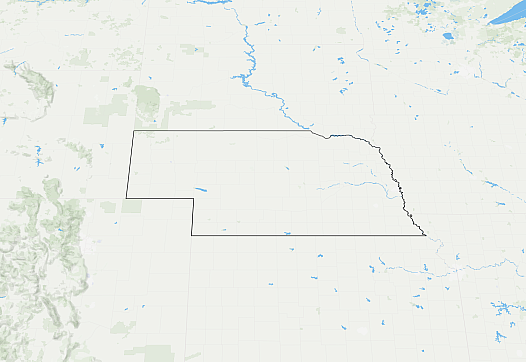No nitrate police: State and local regulators can’t, or won’t, stop our drinking water from getting worse
The story was originally published in Flatwater Free Press with support from the USC Annenberg Center for Health Journalism’s 2022 National Fellowship.

Farmer Jason Othmer operates a combine as he harvests corn near Vesta, an unincorporated community in Johnson County in southeast Nebraska on Tuesday, Oct. 18, 2022.
(Photo by Ryan Soderlin for the Flatwater Free Press)
The farmer was growing impatient. He folded his arms. Shook his head angrily.
He and dozens of other central Nebraska farmers had gathered for mandatory training in Columbus a few weeks before Christmas last year. In response to stubbornly high nitrate levels, the Lower Loup Natural Resources District had designated a slice of the region a “Phase 3 area.” That designation led to a few new requirements – like this training to help farmers manage their nitrogen fertilizer use and reduce nitrate leaching.
The farmer didn’t like this. He told NRD leaders that he had been drinking water containing nitrate at 40 parts per million – quadruple the safe drinking water standard – all his adult life. He was fine, he told them.
During the morning session, he stormed out.
“I’m gonna go pollute the water,” he told the NRD’s assistant manager, Tylr Naprstek, right before he left, Naprstek recalled.
There was precious little Naprstek could do.
He couldn’t fine the farmer. He couldn’t send a cease and desist letter. He couldn’t issue a written or verbal warning. He couldn’t do much except mandate this training. And ask nicely.
“We can try to educate, and as long as he stays within the boundaries of our rules and regs, that’s really all we can do,” said Naprstek.
Even as Nebraska’s water grows increasingly laced with nitrate – a reality that deeply worries the experts studying links between elevated nitrate and pediatric cancers – the regulators meant to keep our water clean either can’t, or won’t, do much to stop practices known to cause nitrate levels to spike.
Local NRDs and the Nebraska Department of Environment and Energy have few staff to monitor Nebraska’s vast swaths of farmland, thousands of cattle feedlots, large hog operations and chicken farms. And even when they identify malpractice, the agencies’ own regulations don’t give the staff many tools to combat it, multiple NRD leaders said.
NRDs can place restrictions on when farmers can apply nitrogen fertilizer. They can mandate water testing and nitrate analysis. They can even hold mandatory training sessions like the one the Columbus farmer stormed out of.
But, crucially, they can’t stop a farmer from applying far more nitrogen fertilizer than is needed – fertilizer that can seep as nitrate into the water supply. Their managers can find themselves hamstrung by their own boards, which sometimes fight against the enforcement of rules that the board itself has previously approved and enacted, according to meeting minutes, interviews and emails obtained by the Flatwater Free Press under public records laws.
The Nebraska Department of Environment and Energy, charged with keeping cattle feedlots from polluting our water supply, can take years to react to feedlots showing sky-high nitrate levels. And even when they do, these regulators often take little action – even as they continue to hand out new feedlot permits “like Halloween candy,” wrote Mike Sousek, Lower Elkhorn NRD General Manager in an email he sent to every NRD leader in Nebraska.
Many farmers use their nitrogen fertilizer responsibly, both state and local leaders stress. They apply it using methods that leach fewer nitrates into our water supply. They take into account nitrogen already in the soil. They embrace technologies and best practices championed by the University of Nebraska, and they save money by using their nitrogen fertilizer more efficiently.
They are the agricultural equivalent of drivers, buckled into their seats, driving comfortably near the speed limit.
But, in Nebraska, there’s little way to enforce rules already in place, rules meant to protect our groundwater.
There’s no one to stop the other driver, the one barreling 90 miles per hour down the highway, crossing the centerline, putting everyone on the road in danger.
“There’s no nitrogen police,” Sousek said.
***
For a glance at how Nebraska’s enforcement can be slow and toothless, look at Engelmeyer Farms.
The West Point feeder cattle and hog facility has had high nitrate in some of its downstream wells since 2007. No one drinks from these wells, but sky-high readings are evidence that nitrate is leaching into the water supply.
In 2011, nitrate readings peaked at an astronomical 413 parts per million.
The Environmental Protection Agency’s safe drinking limit for nitrate is 10 parts per million.
Only in August – fifteen years after the initial high readings – did the NDEE conduct a “compliance status inspection” of Engelmeyer Farms because of high nitrate, according to the state’s available public records.
Three prior, more general inspections found the feedlot owner failed to provide proof that they properly inspected waste or manure application tools. Despite the high levels – some of the highest ever recorded in Nebraska – the state’s only guidance was that Engelmeyer Farms needed better record-keeping.
The NDEE’s enforcement at Engelmeyer Farms actually exceeds the work that the department does at other feedlots with high nitrate levels, according to public records.
Five feedlots near Wisner frequently reported far higher nitrate levels than their surroundings in the past 10 years, a Flatwater Free Press review of Wisner area livestock facilities with monitoring data available showed.
Inspectors sometimes noted concerns during visits to these feedlots.
On all five of these feedlots, the department’s groundwater section recommended nothing beyond continued monitoring.
There are 2,600-some active permits for concentrated animal feeding operations, or CAFOs, in the state. Most are cattle feedlots, large hog operations or chicken farms.
Only 367 have been required to install monitoring wells and report water quality results, according to a list provided by state regulators in April.
Four or five staff members in the groundwater section – who have many other duties – are also tasked with reviewing the tests these CAFOs submit twice a year, said NDEE Groundwater Section Supervisor David Miesbach.
“I see it all the time. If I got alarmed by every time I saw something over 10 ppm, it would be a tough day,” said Miesbach.
Miesbach defended the department’s work, saying he and a small staff work with livestock operations diligently, identifying the worst cases, trying to determine where the nitrate is coming from and experimenting with numerous ways to bring levels down.
The department does regulate manure runoff. However, once the manure is applied to farm fields, it becomes local NRDs’ responsibility, NDEE leaders said.
Livestock operations have planted trees and built new waste lagoons to try to improve water quality, he said.
Some of these measures could cost the owners millions of dollars, Miesbach explained. The high cost is one reason the state needs to thoroughly study the site before asking owners to change, he said.
The Flatwater Free Press requested the total number of CAFOs that state regulators have worked with, as well as the total number of livestock producers known to have nitrate issues.
The NDEE didn’t provide a list of livestock facilities it has worked with to address high nitrate. Miesbach said he couldn’t detail when the NDEE will fully determine the causes of high nitrate in livestock facilities with high readings, or how long it will take to address those problems.
The Flatwater Free Press also made a public records request for five years of emails from roughly 80 department employees that mentioned the keywords, “nitrate,” “nitrogen,” “nutrient” and “fertilizer.”
The department quoted the newsroom $44,103.11 to obtain those public records.
This week, the Flatwater Free Press sued the NDEE, claiming the department offered a “legally insufficient and invalid estimate” for those public records.
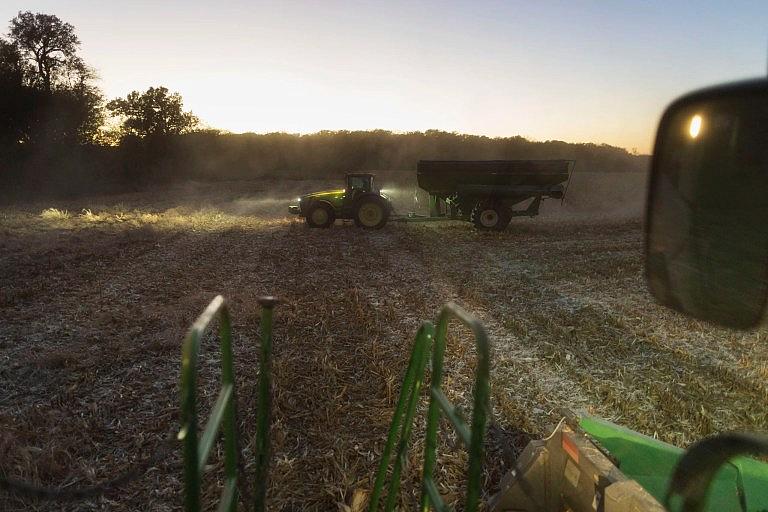
A grain cart waits to be loaded as farmer Jason Othmer harvests corn near Vesta, an unincorporated community in Johnson County in southeast Nebraska on Oct. 18. Othmer and many Nebraska farmers voluntarily take steps to use less fertilizer than farmers of previous eras did. But others often use way more fertilizer than is recommended by the University of Nebraska-Lincoln, which allows more harmful nitrate to leach into the groundwater. For a variety of reasons, regulators either can’t or won’t stop them. “There’s no nitrogen police,” said Mike Sousek, general manager of the Lower Elkhorn Natural Resources District. Photo by Ryan Soderlin for the Flatwater Free Press
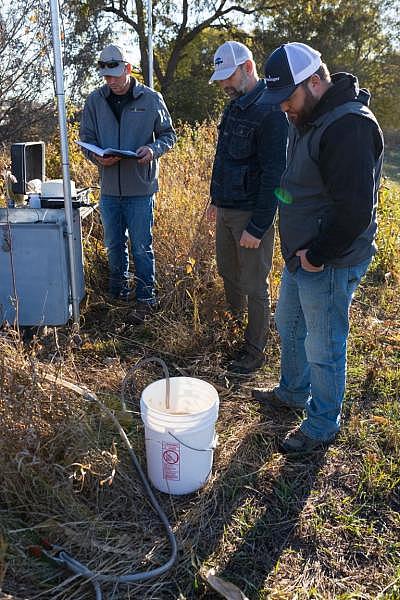
Water resources technicians Josh Schnitzler, left, and Connor Baldwin, right, and assistant general manager Brian Bruckner, center, who all work for the Lower Elkhorn Resources District in Norfolk, test the water in a monitoring well near the north fork of the Elkhorn River. These wells, located roughly 10 miles northwest of Elkhorn, are used to monitor ground water for nitrates and other substances like solids and sulfates. Photo by Ryan Soderlin for the Flatwater Free Press
To Jim Bendfeldt, a longtime farmer near Kearney, there’s nothing more refreshing than drinking cool water his irrigation wells pump in the summer. His family members often cup their hands and scoop water flowing from the irrigation pipes in his fields.
But he won’t let his grandchildren have more than a few gulps, because some of his irrigation wells are high in nitrate.
Slightly less than a quarter of all the Central Platte NRD’s certified irrigated acres – that’s some 225,000 acres – have average nitrate levels that exceed 15 parts per million, 150% the federal safe drinking water standard.
In the past four years, farmers in this area have self-reported using much more nitrogen fertilizer than UNL recommended – on average, 22% more, according to a Flatwater Free Press analysis of data obtained in a public records request.
Some local regulators believe that these self-reported figures are low. Bendfeldt, also an NRD board member, said sales records would show that farmers in the area are using even more. The NRD has no authority to ask for these sales records or identify who’s overapplying nitrate.
“We have no authority to do anything other than accept the online records … and take each producer (at their) word,” he said.
Many farmers and agricultural interest groups cast the nitrate problem as a legacy issue that stems from past practices. They argue that golf courses and lawns are to blame. At NRD board meetings, they protest that more studies are necessary before regulators institute rules that restrict how they farm. They say authorities need to tailor regulations and account for weather, geology and other factors.
“I think there can’t be just a flat standard,” said Nebraska Farm Bureau President Mark McHargue. “We have to base it on science all the way through, so that involves, what types of crops you’re growing, what’s your rotation, what your rainfall is, what your slope on the soil is, what your organic matter is in your soil.”
But the science shows that most nitrates in our water come from fertilizer applied to crops. Years of results from these “nitrate fingerprinting” tests in multiple NRDs point to commercial fertilizers as the most common culprit. The bulk of these fertilizers are applied to corn, said multiple NRD leaders.
Data requested by the Flatwater Free Press shows that farmers in many parts of Nebraska continue to put on more fertilizer than UNL recommends – even though critics say that the UNL recommendations are focused on yield, and should be lower if the damage to our water supply is taken into account.
The free market can help, some argue. Farmers have no incentive to overapply nitrogen, particularly with fertilizer prices so high.
“If farmers blindly apply nitrogen without knowing what’s in the soil or what’s in their manure or what their crop needs are, they’re literally throwing money out the window, and they’re not going to do that,” said Andy Scholting, the founder of Nutrient Advisors, a consultant to both livestock and crop producers.
But an entire industry is built around encouraging Nebraska farmers to use more fertilizer, argues Ronda Rich, an Upper Big Blue NRD board member.
Agronomists are often paid on yield, she said. People who sell fertilizer also advise farmers on how much fertilizer to buy.
Armed with few tools, local regulators can’t do much to combat this, she said.
Yet the regulators themselves are far from blameless, said Tim Gragert, a Republican state senator from Creighton. Gragert once worked for the Natural Resources Conservation Service, which helps farmers with soil health. He sits on the Legislature’s Natural Resources Committee, and authored new laws, one that created a task force that studied nitrate and another that strengthened nitrate education.
He doesn’t mince words on Nebraska’s Natural Resources Districts.
“They’ve already been given that authority to do what they need to do. They’re not doing it,” he said.
***
In late 2020, staff in the Lower Elkhorn NRD proposed that an area should be elevated to Phase 2 in parts of Cuming, Colfax and Dodge counties, subjecting the area to heightened regulations to control nitrate leaching.
They did so after nitrate levels had met the threshold laid out in the district’s own rules – rules the elected NRD board had previously approved.
But the board decided not to go along with its own rules. It tabled the motion to go to Phase 2 – which would have imposed more regulations, including a ban on fall and winter application of nitrogen fertilizer, an 80-pound maximum of nitrogen fertilizer per single application, and mandatory soil and water sampling. Instead, it voted to conduct more testing.
“We seem to want to just kick this can down the road to just study,” Sousek said at the board’s September meeting. “We’ve had this in place in Pierce County for 20 years and we’re still studying, and the problems aren’t getting any better. ”
After a long pause, he continued: “If we aren’t gonna follow our own rules, maybe we need to change our rules.”
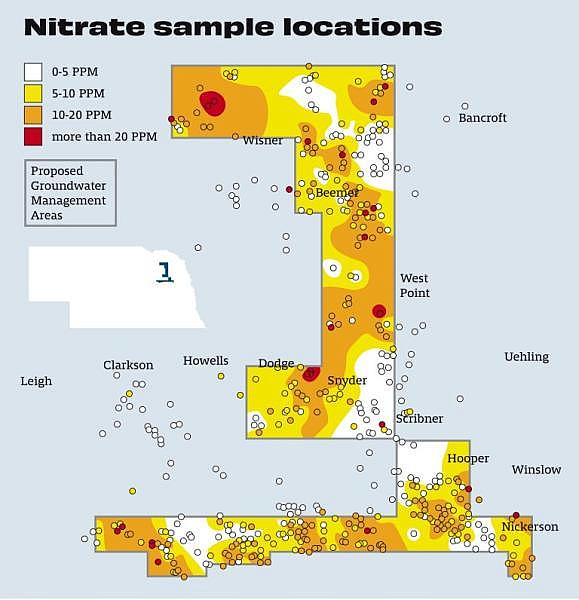
Lower Elkhorn Natural Resources District staff proposed a groundwater management area in 2020 after the median nitrate levels in 460 square miles of Cuming, Dodge and Colfax counties hit the district’s threshold for Phase 2 — at least 20% of the monitored wells have nitrate concentrations between 5 and 9 parts per million. The designation would have subjected the area to heightened regulations such as a ban on fall and winter application of nitrogen fertilizer. The NRD’s board declined to go to Phase 2, and instead voted to conduct more study. (Data: Lower Elkhorn NRD/Map: Hanscom Park Studio)
This sort of tension isn’t uncommon. Leaders of natural resources districts – local government units created by the state to protect natural resources – often find themselves being slowed down or opposed by board members, who are locally elected, when the leaders try to enforce rules related to water quality.
At the same meeting, Matt Steffen, a board member from West Point, argued that the rules should differentiate different soil types and the board should wait for the test results to come in. “This information is going to greatly help people understand.”
Mark Hall, the chair of the board, agreed that it’s best to wait for more study.
“We’re talking about what I would consider maybe a 70-year-old problem, and we’re going to make a decision within one year to affect the whole area. I would rather be a little conservative and make sure we understand the science before we make a change,” he told the Flatwater Free Press.
That inaction frustrates both NRD staffers and board members who favor regulation, who argue that their own test results have shown nitrate levels are getting higher – and that they likely affect area residents’ health. For example: Nebraska has the highest pediatric cancer rate west of Pennsylvania, and many of these cancers, researchers say, are linked to high nitrate levels.
Board member Joel Hansen urged the full board to at least vote on creating the Phase 2 area.
“The board’s making the decision not to follow our own rules by not doing anything,” Hansen said in an interview.
But being a board member who favors regulation is often a good way to lose your board seat.
In the November election, Hansen was defeated by Plainview farmer Jim Aschoff, who was once issued a cease and desist order for failing to submit an annual report on his fertilizer use, yield goal and his land’s water quality.
What happened in Lower Elkhorn NRD isn’t an isolated case.
In 2019, a board committee of the Upper Big Blue NRD discussed introducing a rule to ban the application of anhydrous ammonia, a nitrogen fertilizer, in the fall in areas where median nitrate level reaches a threshold. The committee then voted to not move forward with this rule change.
Later that year, the board proposed another rule to require split application, a method of applying fertilizer to reduce the amount of nitrate that seeps into the water. Another proposed rule would have capped the amount of fertilizer that can be applied in certain areas before April 1.
More than a dozen residents, mostly farmers, spoke at the public meeting to oppose the rules or ask for additional studies. The board then voted to remove the proposed changes.
Three years after the board scrapped these rule changes, nitrate levels have spiked. Eight of the district’s 12 zones had an increase in median nitrate levels. In three of these zones, at least half of the sampled private wells — which provide drinking water to rural residents — now have nitrate levels higher than the 10 ppm safe drinking water limit, according to the NRD’s most recent test results.
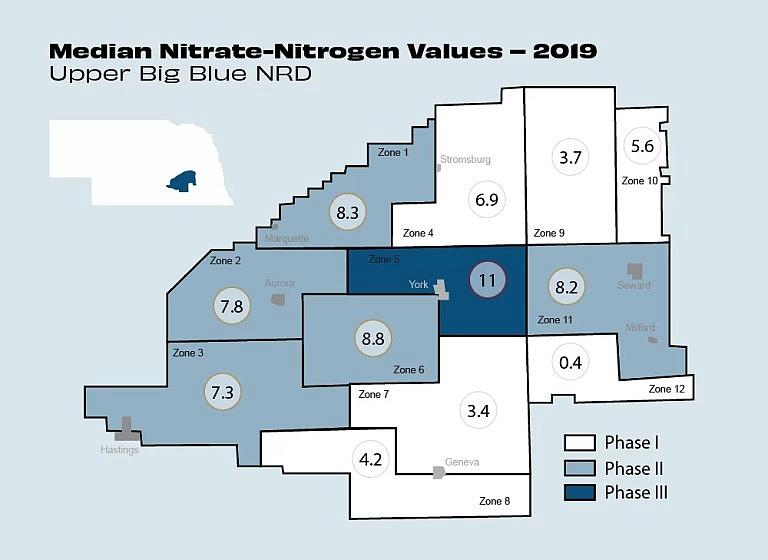
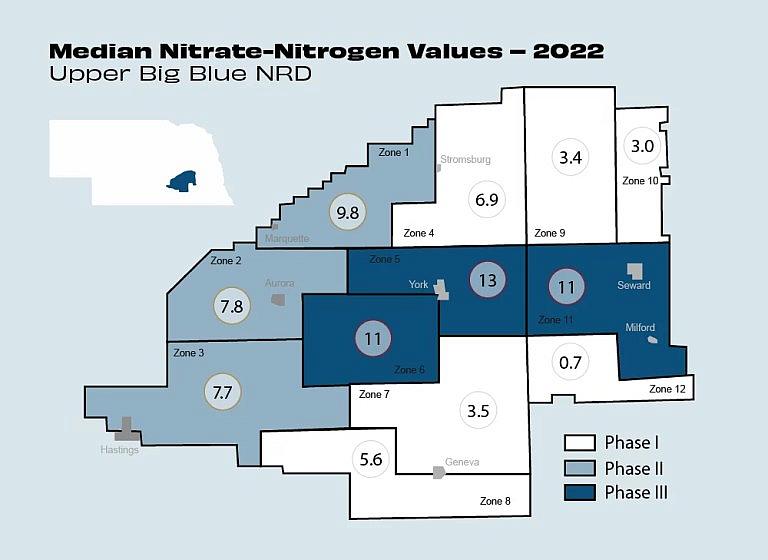
In many areas, median nitrate levels in Upper Big Blue NRD have trended up between 2019 and 2022. (Data: Upper Big Blue NRD / Maps: Hanscom Park Studio)
The NRD Phase System, Explained
Nebraska’s Natural Resources Districts commonly create phase areas to address high nitrate. Each NRD sets their own rules and thresholds for these different phases, but all have trouble enforcing the requirements these phases are meant to trigger.
Phase 1: Areas that have the lowest levels of nitrate. Usually no reporting or other requirements, depending on the NRD. Some NRDs require training and groundwater analysis for nitrate at this level.
Phase 2: “Special management practices” typically start here. They sometimes include bans on commercial fertilizer application in the fall and winter, because applying fertilizer then is more likely to cause nitrate leaching into the water supply.
Phase 3: Additional requirements are sometimes put into place. In Phase 3, some NRDs try to discourage the use of anhydrous ammonia by requiring that farmers also use an inhibitor chemical that helps stop this type of fertilizer from leaching nitrate into the soil. Some NRDs require split application, which limits the amount of nitrogen fertilizer at any one time.
Phase 4: Only certain NRDs even have a Phase 4 on the books – a phase actually meant to limit the amount of fertilizer that can be used.
But no NRD has ever designated any area Phase 4, NRD leaders said.
Central Platte NRD General Manager Lyndon Vogt said there probably should be some areas in this phase. “If we were to go to a Phase 4, we don’t have the ability to enforce that,” Vogt said. “I think everyone’s struggling with what that next step is.”
Self-reported data from the district shows farmers on average have applied more than the UNL recommended level of nitrogen fertilizers in the past four years.
Rich, the Upper Big Blue NRD member, said her board, packed with members with tight connections to agriculture, has failed its duties in educating the public about the threat of nitrate.
Some board members actively seek to hamstring efforts to strengthen regulations, she said. Some board members repeatedly vote no on issuing cease and desist orders to farmers who fail to comply with the district’s rules – even though those rules, like reporting your nitrogen fertilizer use, don’t even carry penalties even if the farmer’s fertilizer use is sky-high.
Rich lost her re-election in November, falling to a challenger who has two brothers already on the NRD board.
At the September board meeting, staff brought in a new University of Nebraska Medical Center study that shows geographic correlation between areas with high pediatric cancer and birth defect rates and areas with high nitrate levels, Rich recalled. The researchers used the NRD’s own data.
The water committee’s chairman John Miller said, “There are some things in there that I personally am not sure are valid.” Miller then quickly ended the discussion on high nitrate and cancer.
A network of consistently monitored wells in the Upper Big Blue district shows that, in the past decade, nine of the district’s 12 zones have seen nitrate levels increase.
***
Two of the wells that supply Wisner’s drinking water have been getting worse for years, and one veered into dangerous territory this year after its nitrate levels shot as high as 11 parts per million.
The town in northeast Nebraska’s Cuming County has issued multiple drinking water notices to its roughly 1,200 residents, and has been forced to provide bottled water to pregnant people, nursing mothers and infants under six months old.
In the meantime, a feedlot a few miles outside town has shown consistently high levels of nitrate in its water. Earlier this year, a monitoring well at the feedlot skyrocketed to 232 parts per million.
State regulators have inspected the feedlot twice since 2018. They have found no issues. They requested nothing from the feedlot’s owners.
In an interview in October, Miesbach confirmed that the monitoring data shows high nitrate, but said he hadn’t yet contacted the feedlot.
This northeast area of Nebraska is home to some 1,800 livestock facilities, the most of any region in the state.
Fewer than 100 of these feedlots and other animal operations even have on-site monitoring wells, said Sousek, the NRD director in the area – meaning that state regulators are flying mostly blind.
Sousek thinks these feedlots, regulated by the NDEE, have contributed to his district’s high nitrate in groundwater, he said in emails obtained by the Flatwater Free Press under public records law.
“On one hand (NDEE) is preaching to the NRD’s that we need to clean this mess up to meet standards, on the other hand they’re handing out permits like Halloween candy,” wrote Sousek in an email he sent to every NRD manager in Nebraska.
The NRD itself has repeatedly stopped short of more aggressively regulating farmers’ use of nitrogen fertilizer.
It has only recently begun sending cease and desist orders to farmers when the farmers repeatedly failed to fill out crop reports. It has declined to bring lawsuits and levy fines against those who refuse to comply with these orders related to nitrate management, though Sousek noted that many farmers do comply after conversations with NRD staff members.
And Sousek’s own board has repeatedly declined to increase regulations, even in areas where nitrate levels are spiking.
As this continues, the water quality in many small Nebraska towns continues to move in one direction.
South.
Nine small towns in Sousek’s district have had at least one nitrate reading above 10 parts per million – the federal safe drinking water standard – since 2017.
In emails obtained by the Flatwater Free Press, the NRD director sometimes sounds a sorrowful note. Like there’s little he and any other regulators can ultimately do. Like nothing will ever change.
“The real legacy issue as I see is our resistance to change in what we consider best management practices, the legacy of doing what we have always done, the statement of…we are doing everything right,” Sousek wrote in an email sent to UNL researchers in February 2021. “We continue to add to the problem.”
Can we incentivize our way out of high nitrate levels?
There’s another way to get nitrate levels in our drinking water down in Nebraska, say some farmers and ag industry leaders.
Use the carrot, not the stick.
Tim Mundorf, the director of soil management at Central Valley Ag, a co-op headquartered in York, argues that more and better incentives can spur farmers to change practices that leach nitrate into the water. Roughly half his clients use at least one of the best management practices.
“We, as a society, need to be on board that we’re going to help the farmer bear some of those costs if we’re going to ask the farmer to change his practices,” Mundorf said. “Those incentives could be better. And I think some of that’s coming.”
Others argue that carrots might help, but only if accompanied by sticks.
Economic incentives alone won’t solve the problem, said Silvia Secchi, a professor at the University of Iowa who specializes in the economic impacts of agriculture.
“Our policies that essentially try to pay farmers to do the right thing are not very good at getting at the problems,“ said Secchi. “The system is set up to fail.”
When the incentives don’t work, some farmers’ behavior won’t change, because the farmer doesn’t solely bear the cost of unclean water.
“The consequences of that overapplication did not accrue to the farmers; they accrued to the rest of us in the pollution of groundwater and surface water,” Secchi said.
This article was produced as a project for the University of Southern California Annenberg Center for Health Journalism’s 2022 National Fellowship.
[This article was originally published by Flatwater Free Press.]
Did you like this story? Your support means a lot! Your tax-deductible donation will advance our mission of supporting journalism as a catalyst for change.


